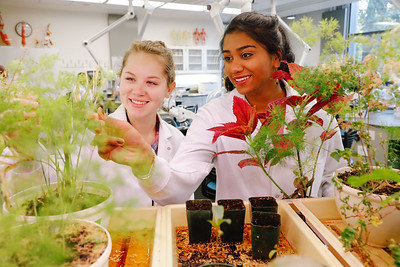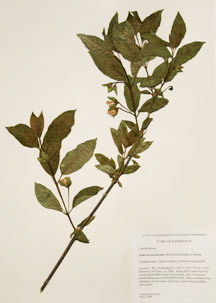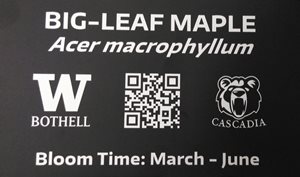UW Bothell Herbarium
About the UW Bothell Herbarium
The UW Bothell Herbarium provides a critical authoritative record of plants occurring in the campus wetland and the greater North Creek Basin. As the vegetation changes through time in the wetland it will form a reliable record to help us and future researchers understand biological and habitat change in one of our regions’ preeminent floodplain restoration projects.

The herbarium is a valuable resource for classes such as BES 490 (Pacific Northwest Plants), BBIO 471 (Plant Ecology), BES 316 (Ecological Methods), and many others. Students use the herbarium as a resource to aid in identifying plants and gain valuable skills working in the herbarium by practicing careful scientific documentation.
The UW Bothell Herbarium is already playing an important role in fulfilling the mission of the Sarah Simonds Green Conservatory: to foster research and educate students and the general public about the natural world in our region.
Search the pnwherbaria.org for UW Bothell Herbarium Online Collection.
What is an Herbarium?

A herbarium (plural: herbaria) is a plant facility that functions in three ways: as a museum, a library, and a scientific lab.
Plants are collected in the field, and details are recorded such as ecology, form, size, and color. They are then pressed in newspaper, allowed to dry, and finally glued on thick paper. The preserved plants are stored in a cabinet, and organized. At the UW Bothell Herbarium, plants are organized alphabetically first by family, then by genus and species. The whole process takes at least 3 weeks, but the specimens can last hundreds of years.
Once plants are preserved, the herbarium holds them in their collection indefinitely. Similar to a library, a herbarium can borrow specimens from another facility so a scientist can use it during research.
Last of all, a herbarium functions as a lab for students and researchers. Students can use the specimens to help their plant identification skills and as an extension to classroom learning. Scientists can use the samples when studying taxonomy or even use the tissues from the plant for DNA and protein samples.
Opportunities
At this time, weekly led plant walks, collections, and CBLR volunteer opportunities are unavailable. If driven students want to find a faculty member to study under, they can gain access to the herbarium to work on their own collections and plant projects. They can do this as a volunteer opportunity, independent project for credit, or independent research for credit. Contact Tyson Kemper for information how to get this started.
Herbarium Team
The herbarium is a space where several members of the community (UW and Puget Sound area) volunteer their time to keep this collection of plants up-to-date and available to researchers, faculty, and students.
- Tyson Kemper, Herbarium Curator – wildhair@uw.edu
- Ashley Shattuck, Botanist/Collector (volunteer)
- Christie Caldwell, Wildlife Biologist (volunteer)
Plant Tags Tour

Students, trail users, and visitors can interact with nature on their own, without a guide, and still have access to high quality information by scanning the plant tags with their phone. This is great for students studying on their own and trying to complete ecology or plant assignments for class. Plant reports were written and edited by students, staff, and UW Bothell Herbarium volunteers. They include photographs, plant specs, how they can be used in restoration or benefit the environment and wildlife, and how the plant may have been used by local native tribes or used commercially.
In the News
- Plants tell their stories with QR codes, March 19, 2020
- Conservatory a base for learning and landscaping, October 3, 2019
- Monitoring and protecting wildlife (and plants), Campus Research Connection, October 3, 2019
- UW Bothell Herbarium now on world index, June 12, 2019
- Connecting wetland to the world, October 2016